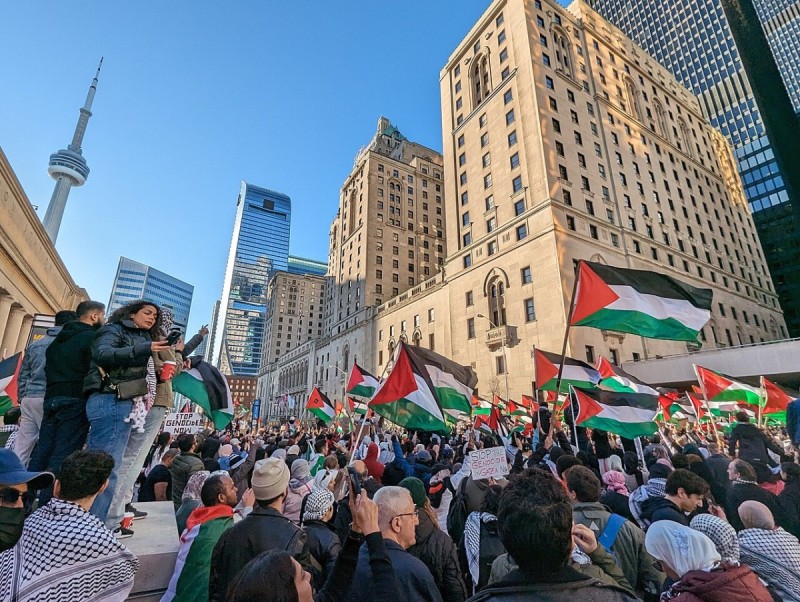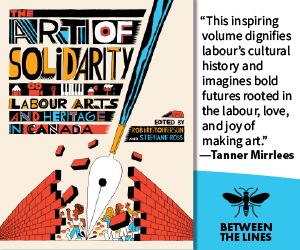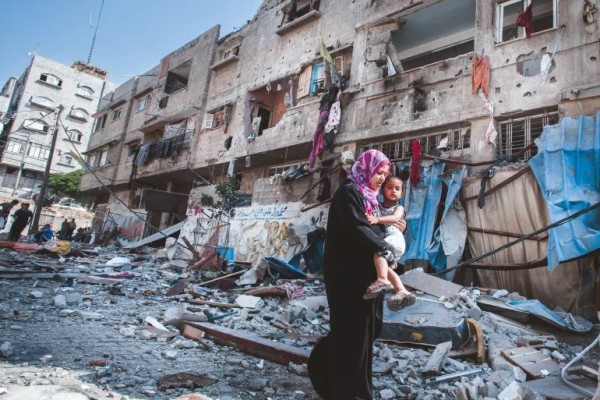Bursting the bubble (zone): Resisting Toronto’s anti-protest bylaw
Lawfare is increasingly being wielded to bolster the state’s ability to repress and criminalize pro-Palestinian movements

Rally in Toronto organized by Toronto4Palestine, October 28, 2023. Photo by Sikander Iqbal/Wikimedia Commons.
Toronto’s new bubble zone anti-protest mechanism, officially known as the “Access to Social Infrastructure” bylaw, is both more and less dangerous than it may appear at first glance. Less because the bylaw’s enforceability—and its constitutionality—are shaky and still to be determined, more because this municipal provision needs to be understood in the context of other bubble zone type legislation and, more broadly, as an example of the lawfare being wielded against pro-Palestinian solidarity and other left movements.
What the ‘Access Area’ bylaw says
The bylaw allows a childcare centre, a place of worship, or a school (“social infrastructure”) to request that all city owned property (including streets, sidewalks, and parks) within 50 metres of the site’s boundary be designated an “access area.” Prohibited activities inside this resulting bubble zone include “acts of discouragement” or “persistent requests” aimed at inhibiting someone’s access to the social infrastructure and expressions of “objection or disapproval” on the basis of race, ethnicity, religion/creed, or other discriminatory grounds.
An access area is established when the owner of a social infrastructure attests that they “reasonably believe” that one of these prohibited activities may occur on city proper located within the proposed bubble zone. The access area remains in place for a full year (and may be renewed) and is enforced by municipal enforcement officers with the support of police “as needed.” A person convicted of contravening the bylaw faces a maximum fine of $5,000.
The bylaw passed by Toronto City Council on May 22, 2025 is actually worse than the version originally proposed by city staff. Bubble zones were expanded from 20 metres and six months duration and the requirement that an applicant show that prohibited activity had actually occurred was removed.
Why it’s a problem
Several red flags are immediately apparent. The most obvious one, as opponents have consistently maintained (and the city itself recognizes), is that this bylaw is simply not necessary. In addition to all the general criminal offences often used to supress dissent (mischief, unlawful assembly, trespass, etc.), police have long relied on their “ancillary powers” to create exclusion zones and designate protest pens. Notable examples include the Toronto G20 and the RCMP’s no-go zones on Wet’suwet’en territory. Less obvious is that there is already a specific Criminal Code offence prohibiting disturbances of religious worship.
But perhaps more crucially, the bylaw’s request-based process privileges powerful voices, providing institutions and communities who already have the resources and know-how to summon the repressive power of the state with another avenue for doing so. Allowing the establishment of access zones on the basis of potential expressive activity amplifies the power of property owners and in effect, privatizes public order policing.
Toronto’s councillors and staff understand this to some extent. In a backgrounder document, the city recognized that “demonstrations are an important means for groups and individuals who historically have not had access to traditional political processes and power to express their opinions, perspectives and experiences, and to advocate for change,” especially Indigenous, Black and equity-deserving communities. Although Toronto maintains that the bylaw “does not prohibit peaceful gatherings, protests or demonstrations… the City recognizes that the existence of bylaw provisions of this nature may result in community members feeling unable to peacefully demonstrate in Toronto.”
Notably absent here is an explicit recognition of anti-Palestinian racism as a driving force for the implementation of this bylaw. From the beginning and right through to council’s final debate, bylaw proponents have attempted to present bubble zones as a neutral measure aimed at protecting generic “vulnerable institutions” rather than what it is: an attempt to bolster the state’s ability to repress and criminalize pro-Palestinian movements specifically.
The bylaw’s weaponization of property rights is exacerbated by its complete lack of clarity on the criteria for evaluating an application to establish an “access area” or the threshold to be met before granting a request. Both the request and prohibitions rely on vague and undefined actions (“an act of disapproval” or “persistently request”) that are not found in other statutes.
(How) will it work?
In fact, the entire bubble zone framework relies on the discretion of city employees and bylaw officers—even before the police get involved. The latter have repeatedly indicated that this is a role they would rather not play. Toronto’s head of bylaw administration and enforcement told the Toronto Star that “police are better suited to deal with these matters and that he doesn’t think his officers should be involved.” Uncertainty about how access areas will be established and enforced is underscored by the city’s backgrounder which makes it clear that city staff view this process as primarily as administrative rather than political, comparing anticipated bubble zone applications to requests for restaurant patios under the Café TO program.
In contrast, much of the opposition to the bylaw has focused on its potential unconstitutionality, especially rights to expression and assembly under the Charter of Rights and Freedoms. The legal advice provided to council by Toronto’s city solicitor has not been made public, but the Toronto Star has reported that in her opinion, even the original version of the bylaw “likely infringes the Charter” although its narrow tailoring arguably made it a reasonable limitation on expressive rights.
Given that the bylaw as passed significantly expands its reach and impact, its constitutionality is doubtful at best. Not only will the reasonableness of bubble zones be more difficult to defend generally, the activities prohibited in access zones may be viewed as “content-based” restrictions—where the legality of political expression rests on interpretations of what people say rather than how or where they express themselves—a much more serious restriction of freedom of expression.
Other bubble zone legislation
Toronto’s public consultations often relied on similar bylaws recently passed by other municipalities. Vaughan’s Protecting Vulnerable Social Infrastructure By-law “prohibits anyone from organizing or participating in any and all nuisance demonstration within 100 metres of the property line of any vulnerable social infrastructure.” Brampton’s Protecting Places of Worship from Nuisance Demonstrations By-law takes a similar approach.
The city canvassed these (along with Calgary’s 2023 bylaw) and noted that Oakville, Mississauga, Hamilton, and Ottawa are also considering bylaws. Largely left out of this discussion is that all three of the existing bylaws clearly target non-violent political expression and none have been constitutionally tested by a higher court.
Toronto also leaves out crucial context in its discussion of two provincial laws. Ontario’s Safe Access to Abortion Services Act does enact bubble zones around clinics but the legislation was meant to replace individual court orders obtained by clinics (often as a result of actual harm or violence and/or sustained harassment) and to protect abortion providers in their homes. BC’s Safe Access to School Act is temporary and was brought in to address anti-trans protests that were not being adequately policed.
The broader context: lawfare
Toronto’s bubble zone bylaw should be understood as an example of lawfare: the strategic use of legal tools to suppress political expression and mobilization. Regardless of its eventual efficacy, it is a weaponization of law against left movements that is dangerous because it echoes other legal and policy developments.
Recent reporting in The Breach on the lawfare playbook of the pro-Israel lobby in Canada examines the Alliance of Canadians Combatting Antisemitism and highlights the passage of “bubble legislation” as one of the Alliance’s goals. Context is essential, the authors note, as the “push to ‘protect’ Jewish institutions was triggered by protests led by Jewish groups outside synagogues, targeting events for real estate pitches in the illegally occupied West Bank of Palestine.” The Alliance’s founder, lawyer Mark Sandler, was invited to Toronto City Hall by Councillor James Pasternak for a roundtable session on the Charter implications of the bylaw with city staff where he defended its constitutionality.
During April’s federal election campaign, Mark Carney cited a “horrifying rise in hate and hate-related crimes in our communities” and “numerous incidents of antisemitism and Islamophobia” and promised to introduce “legislation to make it a criminal offence to intentionally and willfully obstruct access to any place of worship, schools, and community centres; and a criminal offence to willfully intimidate or threaten those attending services at these locations.”
Lawfare also takes the form of legislative enactments squarely aimed at protest and political expression. For example, so-called agricultural gag (“ag-gag”) laws target journalists and workers who publicize abuses in animal agriculture operations. A federal ag-gag bill described as a “serious threat to transparency within the Canadian food system” that would “impede undercover investigations and whistleblowing efforts” made it through third reading earlier this year before dying on the order paper. Ontario and Alberta have existing ag-gag statutes, although a court struck down part of Ontario’s Security from Trespass and Protecting Food Safety Act last year, finding that it unconstitutionally penalizes expression that has no bearing on objectives like animal safety or food security.
Finally, bubble zones should be considered a form of critical infrastructure legislation. Widely adopted in the United States, Alberta is currently the only province (but is unlikely to be the last) to specifically criminalize interference with “essential infrastructure” such as rail lines, pipelines, and highways. The Critical Infrastructure Defence Act was introduced in the wake of the #ShutDownCanada Wet’suwet’en solidarity protests in early 2020 and so far, courts have upheld its constitutionality.
Courts may well uphold all or part of Toronto’s bylaw as well. But before the inevitable Charter challenges, activists and organizers need to continue pushing back against the implementation of bubble zones. Creative tactics and strategic resistance are far likelier to claim and hold space for expression and collective action on Toronto’s streets than the law or city hall. Especially in these moments of increased repression, we keep each other safe.
Irina Ceric is an Assistant Professor at the University of Windsor Faculty of Law. She works with the Movement Legal Defence Committee and the Community Justice Collective.









_600_400_90_s_c1.jpeg)
